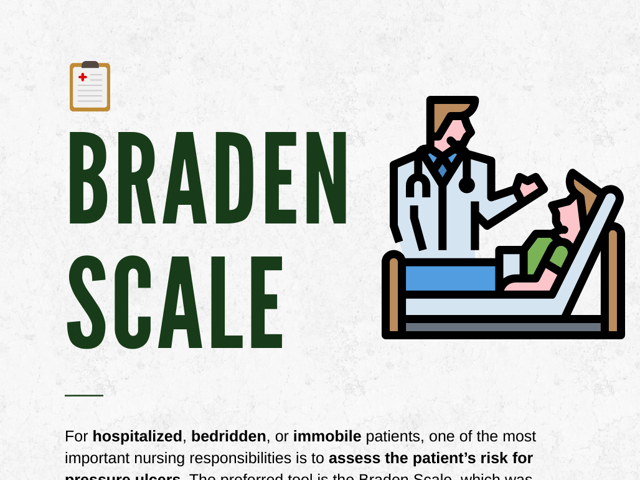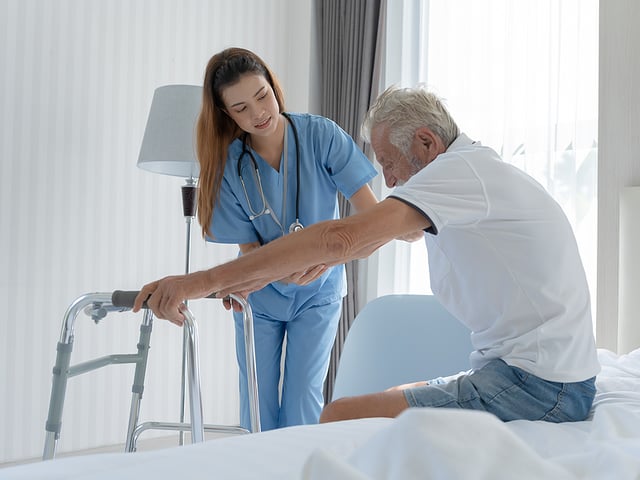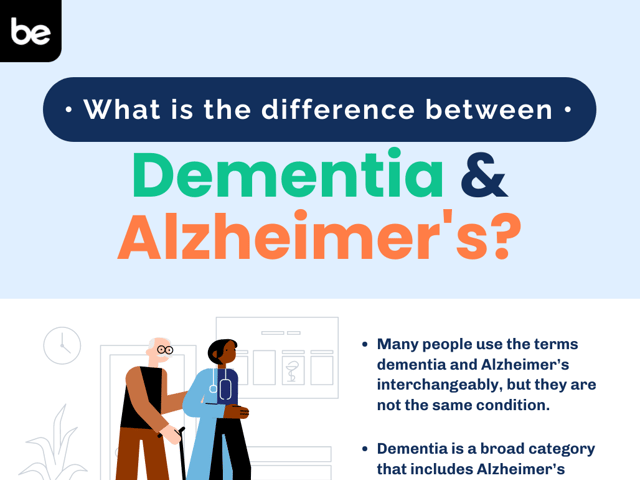
The Braden Scale
For hospitalized, bedridden, or immobile patients, one of the most important nursing responsibilities is to assess the patient’s risk for pressure ulcers. The preferred tool is the Braden Scale, which was developed by nurses. There are six categories of assessment.
Six Categories of Assessment
Category 1: Sensory Perception
When assessing the patient’s sensory perception, the goal is to determine how well the patient can respond to pain or discomfort related to pressure. As the patient’s sensory perception deteriorates, their ability to communicate discomfort from pressure declines, and the patient is at higher risk for developing a pressure ulcer.
1. Completely Limited
The patient is unconscious, unresponsive, or sedated; the patient does not show a reaction to painful stimuli; or the patient is not able to feel pain throughout most of their body due to a sensory impairment, such as a quadriplegic.
2. Very Limited
The patient shows a reaction to only painful stimuli; the patient’s communication of discomfort is limited to moaning or restlessness; or the patient is not able to feel pain in half of their body.
3. Slightly Limited
The patient responds to verbal commands but does not reliably communicate their discomfort or need to be turned; or the patient is unable to feel pain in one or two extremities.
4. No Impairment
The patient has no sensory deficit, responds to verbal commands, and is able to feel and communicate pain and discomfort.
Category 2: Moisture
The assessment of this category determines the degree to which and how often the patient’s skin will be exposed to moisture, which increases the risk of developing a pressure ulcer.
1. Constantly Moist
The patient’s skin is constantly moist, which may be related to perspiration or incontinence; skin is damp nearly every time the patient is turned or repositioned.
2. Very Moist
Skin is often but not always moist; bed linens and gown need to be changed every shift.
3. Occasionally Moist
Skin is occasionally moist; bed linens and gown need to be changed once a day.
4. Rarely Moist
Skin is usually dry; bed linens and gown are changed at a normal routine interval.
Category 3: Activity
When assessing the patient’s activity, you will consider the degree of physical activity possible for the patient. This may be assisted or unassisted, and in fact, it is one of the main reasons that helping patients ambulate can be beneficial as it helps the blood circulate and relieves pressure off of the pressure points.
1. Bedfast
The patient is confined to the bed; this patient is never out of the bed.
2. Chairfast
The patient can sit in a chair but cannot ambulate, or ambulation is severely limited; the patient cannot bear their own weight and usually must be assisted from the bed to the chair; this may be a wheelchair-bound patient.
3. Walks Occasionally
The patient can walk short distances with or without assistance; aside from the occasional ambulation, they spend the majority of the shift in a bed or chair.
4. Walks Often
The patient walks outside of their room at least twice a day and walks inside of their room at least once every two hours while awake.
Category 4: Mobility
While assessing activity focused on the patient’s ability or inability to get out of bed and ambulate, the mobility assessment is concerned with the patient’s ability to change or control their body position without assistance. If the patient is less able to change positions or control their position, such as a patient that slides down in the bed and needs assistance to return to a better position in the bed, their risk for staying in a position where a pressure ulcer may develop is higher.
1. Completely Immobile
The patient is incapable of making even slight changes to their body position; the patient cannot move any of their extremities independently.
2. Very Limited
The patient makes occasional slight changes in their body position or in the position of an extremity, but they are unable to make frequent changes and/or they require assistance to make significant changes to their position.
3. Slightly Limited
The patient makes frequent but slight changes to their position or the position of an extremity independently.
4. No Limitation
The patient is able to independently make frequent and significant changes to their position.
Category 5: Nutrition
When assessing the patient’s nutrition, you will be looking at the patient’s usual intake or their intake given their current condition. While malnutrition has a number of negative side effects, interestingly, there is a strong correlation between malnutrition and development of pressure ulcers. Additionally, nutrients are needed to encourage wound healing, so if a pressure ulcer does develop, a malnourished patient will struggle to heal this wound. And if a patient is losing weight as a result of malnutrition, their bony prominences may be more pronounced, which also can lead to pressure ulcer development.
1. Very Poor
The patient never eats a complete meal and rarely eats more than a third of a given meal; the patient eats two or fewer protein servings a day, does not take a liquid nutritional supplement, and has poor fluid intake; the patient may also be on NPO status and/or on a clear liquid diet or IV feeding for more than five days.
2. Probably Inadequate
The patient rarely eats a complete meal and usually eats one half of the food offered; the patient consumes three servings of protein a day and occasionally takes a nutritional supplement; the patient may also receive less than the optimal amount of a liquid diet or tube feeding.
3. Adequate
The patient usually eats more than one half of a given meal; the patient eats four protein servings per day; while the patient occasionally refuses a meal, they usually take an offered nutritional supplement; the patient may also be on a tube feeding or TPN regimen that probably meets their nutritional needs.
4. Excellent
The patient eats most of every meal and never refuses a meal; the patient consumes four or more protein servings per day; the patient occasionally eats in between meals and does not require any supplements.
Category 6: Friction/Shear
When assessing the patient’s friction and/or shear, you will focus on how often bed linens or gowns cause friction against the patient’s skin, which could lead to abrasions or tears, especially if the skin is thin or fragile. This may happen when a patient is in the bed or a chair and lacks the ability to maintain their position or body alignment, and thus slides down against bed linens and their gown. This is the only category with only three criteria.
1. Problem
The patient requires moderate to maximum effort when moving or changing position and is unable to lift themselves enough to not cause friction with the sheets; the patient often slides down in the bed or chair and requires repositioning with maximum effort; the patient has spasticity, contractures, or agitation that causes almost constant friction between the skin and the sheets.
2. Potential Problem
The patient moves feebly and requires minimal assistance when moving or changing position; when moving, the patient’s skin probably slides against the sheets to an extent; the patient maintains relatively good position in the bed or chair but occasionally slides down.
Using Patient Scores for Treatment
After assessing the six categories of the Braden Scale, you will then add the findings in each category to arrive at the patient’s score. This score will determine what risk factor the patient falls into for developing a pressure ulcer, which may impact patient care decisions and interventions.
- Patient score of 19-23: Patient is not at risk for developing a pressure ulcer and does not require preventive interventions
- Patient score of 15-18: Patient is at risk and requires preventive interventions such as:
- A regular turning schedule
- Increased physical activity
- Heel protection
- Pressure redistribution surfaces
- Management of moisture, friction, and shear as needed
- Patient score of 13-14: Patient is at moderate risk and requires preventive interventions such as:
- All of the interventions for an at-risk patient
- Positioning the patient at a 30-degree lateral incline using foam wedges
- Patient score of 10-12: Patient is at high risk and requires preventive interventions such as:
- All of the interventions for a moderate-risk patient
- Additional small, frequent shifts in the patient’s position
- Patient score of 9 or below: Patient is at very high risk and requires preventive interventions such as:
- All of the interventions for a high-risk patient
- For patients with severe pain or additional risk factors, the addition of a pressure redistribution surface

Keep Reading

National Council Licensure Examination-Practical Nurse Blog
How Long Should I Study for the NCLEX-PN?
For aspiring nurses, the NCLEX-PN is a critical hurdle on the path to b…

National Council Licensure Examination-Practical Nurse Blog
How to Become an LPN
Would you like to average $30 dollars per hour in a rewarding full-time…

National Council Licensure Examination-Practical Nurse Blog
What Is the Difference between Dementia and Alzheimer’s?
Many people use the terms dementia and Alzheimer’s interchangeably, but…